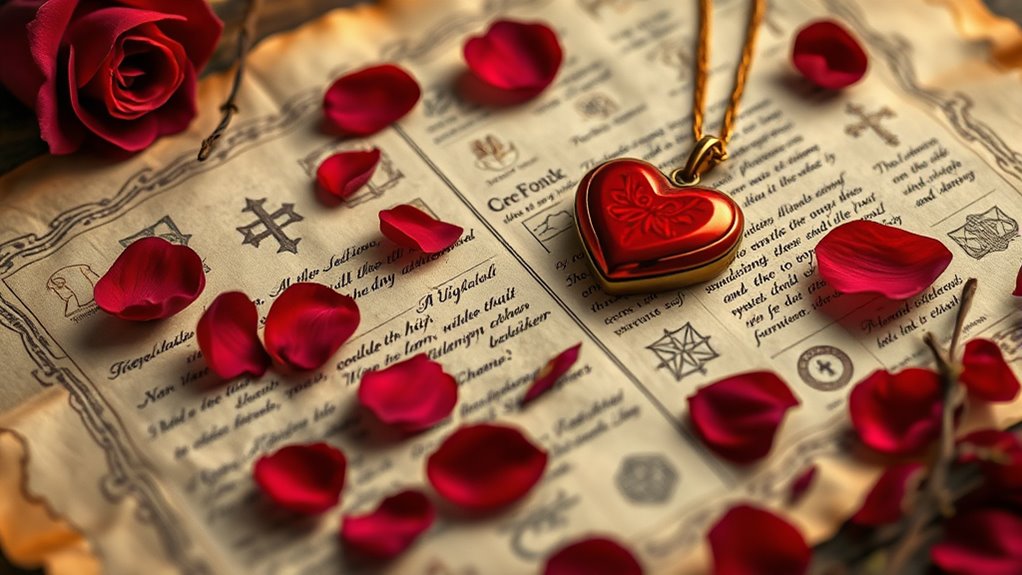Valentine’s Day started as a religious celebration honoring Saint Valentine, a martyr associated with love and sacrifice. Over time, it shifted to a broader cultural event, linked to legends of romance and bird mating season, inspiring people to exchange love notes and gifts. Today, it’s a global holiday filled with flowers, cards, and romantic gestures. Its history shows how a day of sacrifice evolved into a celebration of love—explore more to understand this fascinating transformation.
Key Takeaways
- Originally a religious feast honoring Saint Valentine, a martyr known for love and sacrifice.
- During the Middle Ages, the day became associated with romantic legends and bird mating symbolism.
- Medieval customs introduced love letters, flowers, and tokens, shaping early romantic traditions.
- Modern times saw commercialization with cards, chocolates, and gifts, shifting focus from religious origins to love celebrations.
- Today’s Valentine’s Day blends ancient legends with contemporary customs, emphasizing love, connection, and cultural significance.

Valentine’s Day has transformed dramatically over the centuries, shifting from a religious feast to a global celebration of love and affection. Its origins are deeply rooted in history, blending legend, religious tradition, and evolving social customs. Originally, the day commemorated Saint Valentine, a figure surrounded by medieval legends that depict him as a symbol of devotion and sacrifice. One popular legend suggests he secretly married couples during a time when Roman Emperor Claudius II banned marriages, believing single men made better soldiers. Another story states he performed miracles and sent love notes from prison, which helped cement his status as a romantic martyr. Over time, these stories merged with Christian traditions, and February 14th became a day to honor love, sacrifice, and faith.
Valentine’s Day originated from legends of Saint Valentine’s devotion, sacrifice, and secret love marriages.
As centuries passed, the celebration broadened beyond its religious roots. During the Middle Ages, the day gained popularity among lovers, partly due to the belief that February 14th was the start of bird mating season. This romantic notion, combined with medieval legends, helped establish Valentine’s Day as a day to express affection through poetic gestures and handwritten notes. People began exchanging tokens of love, such as love letters, flowers, and small gifts. These modern customs grew out of the medieval period’s emphasis on romantic devotion, gradually evolving into the festivities we recognize today. Additionally, the commercialization of the holiday has significantly expanded its scope, making it a major economic event in many countries.
In the modern era, Valentine’s Day shifted from a primarily religious observance to a commercialized holiday celebrated worldwide. The traditions that originated from medieval legends—sending love notes and giving flowers—have become widespread customs. Hallmark cards, chocolates, and romantic dinners now dominate the holiday, transforming personal expressions of love into significant economic events. Despite this commercialization, the core idea remains the same: celebrating love and connection. You might now see couples exchanging heartfelt messages, or friends sharing tokens of appreciation. Yet, at its heart, Valentine’s Day still honors the themes of sacrifice and devotion that date back to those medieval legends.
Throughout history, the holiday has continually adapted, blending ancient stories with modern customs. From its religious beginnings to its status as a global celebration of romantic love, Valentine’s Day reflects the enduring human desire to connect and express affection. Whether through grand gestures or simple notes, the holiday’s evolution underscores its timeless appeal. You can see how it’s grown from a day of martyrdom and legend into a vibrant, multifaceted celebration of love’s many forms—an evolution that keeps the spirit of Saint Valentine alive in every act of kindness and affection shared today. This ongoing transformation highlights the importance of understanding the history and traditions behind holidays to appreciate their deeper significance.
Frequently Asked Questions
How Did Valentine’s Day Become a Global Celebration?
You see, Valentine’s Day became a global celebration through historical origins rooted in Christian tradition and the influence of cultural diffusion. As European explorers and colonists traveled, they brought the holiday’s customs to new regions. Over time, countries adopted and adapted these traditions, making Valentine’s Day a worldwide event celebrating love and affection. This spread reflects how cultural diffusion helps unify diverse societies under shared celebrations.
What Are Some Unique Valentine’s Day Traditions Worldwide?
You’ll find that unique Valentine’s Day traditions worldwide showcase diverse cultural rituals and regional customs. In Japan, women gift chocolates to men, while in South Korea, couples exchange love locks on bridges. In Denmark, friends give pressed white flowers called snowdrops, and in the Philippines, giant street parades celebrate love. These customs reflect local beliefs and social practices, making Valentine’s Day a vibrant, multicultural celebration that varies beautifully across regions.
When Did Gift-Giving Become Central to the Holiday?
Think of Cupid’s arrow striking your heart — that’s when gift-giving truly took center stage in Valentine’s Day. Around the 14th and 15th centuries, romantic customs and gift traditions blossomed, especially among the European elite, who exchanged tokens of love like flowers, chocolates, and handwritten notes. This shift made gift-giving a powerful way to express affection, transforming Valentine’s Day into a celebration of love’s tangible expressions.
How Has Valentine’s Day Impacted Modern Pop Culture?
Valentine’s Day shapes modern pop culture through romantic symbolism and commercial influence. You see it in movies, music, and social media, often emphasizing love and affection. Retailers boost sales with themed gifts, cards, and decorations, making it a commercial event. This holiday influences how people express feelings, blending genuine emotion with commercial appeal, creating a cultural phenomenon that celebrates love while driving consumer spending.
Are There Any Lesser-Known Historical Figures Associated With Valentine’s Day?
You might not know that ancient legends and forgotten saints are connected to Valentine’s Day. Besides Saint Valentine, lesser-known figures like Saint Dwynwen from Welsh legend or Saint Walburga, who was honored in parts of Germany, played roles in early traditions. These saints’ stories, though less famous, contributed to the holiday’s history by inspiring love and devotion, shaping the day’s evolving significance across different cultures.
Conclusion
As you’ve seen, Valentine’s Day’s journey from martyrdom to romance is full of surprises. It’s funny how history’s twists and turns brought us to today’s celebration of love, almost like the universe conspired to make it happen. So, next time you exchange cards or flowers, remember—sometimes, the most unexpected coincidences shape what we cherish most. Love, after all, often finds a way, just like history’s charming surprises.









